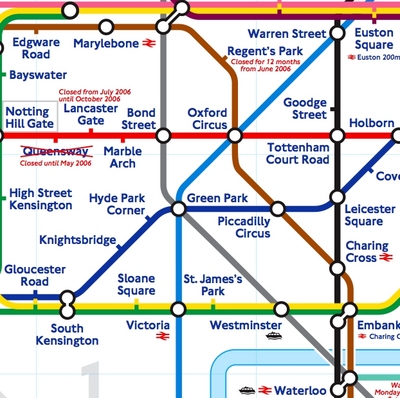Going Dark Age on the Circle Line October 12, 2010
Author: Beach Combing | in : Medieval , trackbackBeachcombing’s trawl around south-east England and London on behalf of Canadian History Student is now three-days old and continues here with another side of London’s Circle Line. The Circle Line for any London virgins among Beachcombing’s readership is the wonderful series of station represented by a yellow circle on the map of central London that goes around in, well, a circle.
Beachcombing and his friends, most of whom are hicks from the sticks, have long felt a certain reverence for the only geometrical line in the metropolis. Indeed, a young Snegly and his brother used to come to London and after a quick visit to the Zoo would ride around and around the Circle Line – Beachcombing kids you not.
Beachcombing still likes a ride on the Circle Line. Partly because he enjoys the idea of ending where he began with some apposite quotations from Heraclitus. Partly because he cherishes the game of spot the suicide bomber: wires sticking out of tee-shirts or tube-goers muttering prayers with unusual intensity. But most of all because it brings Beachcombing close to Dark Age London.
Not that Dark Age London existed in any real sense. After the Romans had sensibly retreated from their Britannia, the city on the river became so much collapsed red tile and brick. But the space that London had occupied was good real estate and was far too valuable to leave to rot and so the Anglo-Saxons moved in and began to farm and generally enjoy themselves.
The proof of this is in the names of the Circle stations themselves. So we have, for example, Paddington, that would have been Padda’s Estate. Padda is a rather unusual but credible Saxon name and Padda evidently had some fields here. The earliest date given for Paddington is 959 but Padda could have easily been, say, a seventh-century landholder.
Or what about Edgeware, in Dark Age times Aeges Wer: as we would say, Ecgi’s Fishing Pool? This first appears in writing too in the tenth century but also could be a couple of centuries older.
Then there is Farringdon, ‘the Ferny Hill’ that was named sometime in the early Middle Ages and that points to a rural London even within the old Roman city limits. Indeed in medieval times reference was made to Farringon Within and Farringdom Without – within and without being the city walls. Dark Age ferns were said to offer invisibility to their wearer: so think vanishing cockneys.
There is too Bayswater that was named in the eleventh century for one of William the Bastard’s henchmen Bainiardus. Nice name but if Bainiardus was William’s London enforcer then he will have been anything but a nice man. As late as the seventeenth century there was still a reference to the original name and sense: Baynard’s Watering.
Aldgate gives us a welcome Roman echo. This was the Old Gate, very likely the aperture in the Roman walls which the road to Colchester took, the road incidentally that Boudicca’s armies charged down in their mission to destroy Roman Londinium.
Then what about Kensington, Cynsige’s Estate (or for pedants the Estate named for Cynsige). A couple of mud huts and a field or two were named for a Saxon here: so what, the reader might say? Well, Beachcombing thrills at the Germanic-sounding name that comes straight out of the bogs of Holland or Jutland. Cynsige was curiously the name of a Dark Age bishop of London. This property may have been associated with him.
Beachcombing implores Canadian History Student to make the pilgrimage and complete the circle: so few do since Snegly got London savvy…
Beachcombing would also like to thank his readers for the various bits of advice for Canadian History Graduate they have passed on. CHG has since written back and asked ‘Perhaps you could suggest a good book as a general overview of London’s history? Failing that, a book focused on late 19th century/early 20th century London.’ Beachcombing was going to suggest Mayhew’s London. Any other ideas or comments on Dark Age Tube names? Drbeachcombing AT yahoo DOT com
***
12 Oct John J who has corresponded with Beachcombing over elephants in North America and road kill has this to suggest for reading matter: If I ever visit the British Isles I would get a tweed jacket, a pipe (and smoke English tobacco imported from Virginia) and a guide book such as The Modern Antiquarian: A Pre-Millenial Odyssey Through Megalithic Britain and spend all my time in the countryside looking for standing stones and other megalithic monuments. Beachcombing dreads to think what the local hoodlums would do to John if he really turned up in tweed and a pipe – ‘Oi Mister…’ – but he seconds the reading suggestion and adds bells. Thanks John and Beachcombing and Mrs B hope that you make it to Britain sooner rather than later.



